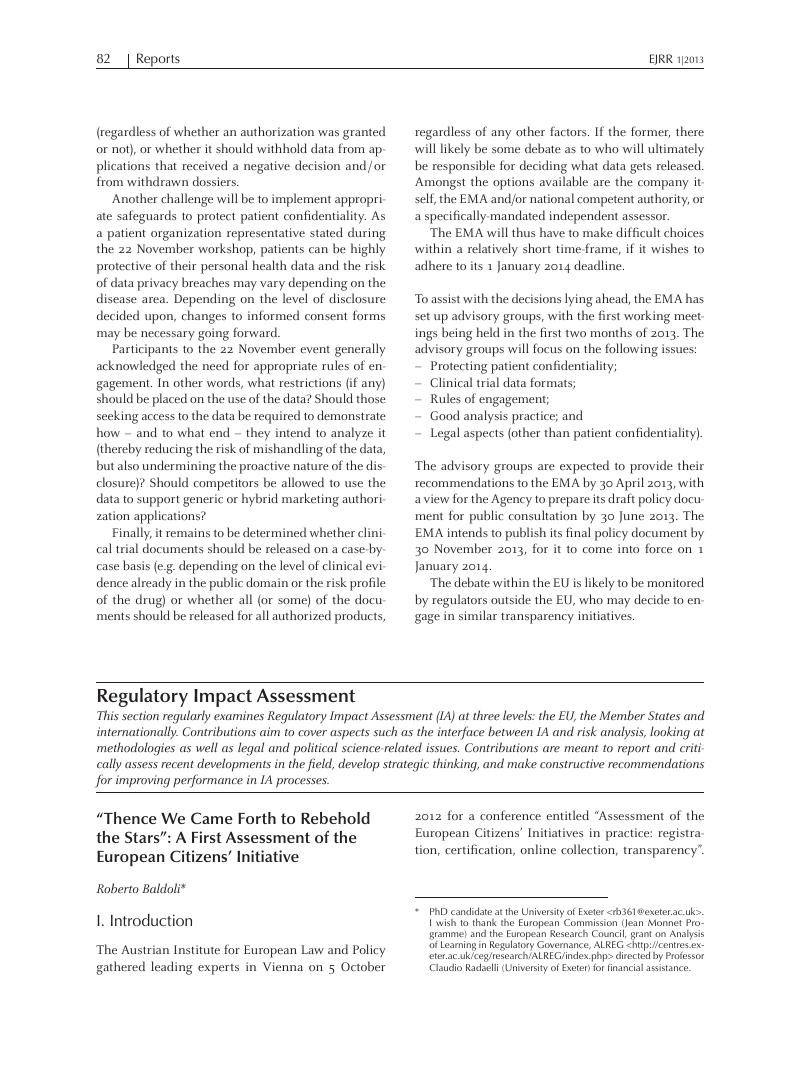No CrossRef data available.
Article contents
“Thence We Came Forth to Rebehold the Stars”: A First Assessment of the European Citizens’ Initiative
Published online by Cambridge University Press: 20 January 2017
Abstract

- Type
- Reports
- Information
- Copyright
- Copyright © Cambridge University Press 2013
References
1 The full flowchart of the ECI process is available on the internet at <http://ec.europa.eu/citizens-initiative/public/how-it-works> (Last accessed on 23 January 2013). A first collective assessment on the ECI is offered in Garcia, Luis Bouza and Greenwood, Justin (eds.), “European Citizens’ Initiative: a First for Participatory Democracy?”, 13 (3) Perspectives on European Politics and Society (2012), pp. 251 et sqq.Google Scholar For a comparative analysis of the ECI and national instruments of citizens initiatives, see Setälä, Marija and Schiller, Theo, Citizens’ Initiatives in Europe, (Basingstoke: Palgrave Macmillan, 2012).CrossRefGoogle Scholar
2 Garcia, Luis Bouza and Villar, Susana Del Rio, “The ECI as a Democratic Innovation: Analysing its Ability to Promote Inclusion, Empowerment and Responsiveness in European Civil Society”, 13 (3) Perspectives on European Politics and Society (2012), pp. 312 et sqq., at p. 312.CrossRefGoogle Scholar
3 For instance, see Joerges, Christian, “The Timeliness of Direct Democracy in the EU – The Example of Nuclear Energy in the EU and the Institutionalisation of the European Citizens’ Initiative in the Lisbon Treaty”, 3 Beijing Law Review (2012), pp. 1 et sqq.CrossRefGoogle Scholar
4 Professor of E-Government at the University of Public Administration Ludwigsburg, Germany.
5 Regulation (EU) No 211/2011 of the European Parliament and of the Council on the Citizens’ Initiative, OJ 2011 L 65/1.
6 Cuesta-López, Víctor, “A Comparative Approach to the Regulation on the European Citizens’ Initiative”, 13 (3) Perspectives on European Politics and Society (2012), pp. 257 et seqq., at p. 262.CrossRefGoogle Scholar
7 See the FAQ available on the internet at <http://ec.europa.eu/citizens-initiative/public/faq> (last accessed on 23 January 2013).
8 See the “Finance” section of the website of the initiative Fraternity 2020 available on the internet at <http://en.fraternite2020.eu/finance.html> (last accessed on 23 January 2013).
9 See the FAQ available on the internet at <http://ec.europa.eu/citizens-initiative/public/faq> (last accessed on 23 January 2013).
10 Monaghan, Elisabeth, “Assessing Participation and Democracy in the EU: The Case of the European Citizens’ Initiative”, 13 (3) Perspectives on European Politics and Society (2012), pp. 285 et seqq., at p. 285.CrossRefGoogle Scholar
11 Professor for Business Computing at the Vienna University of Economics and Business.




